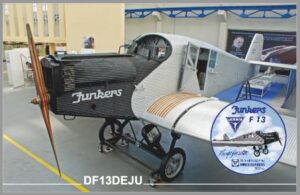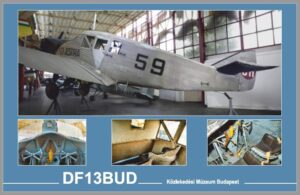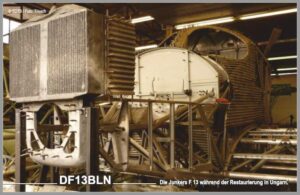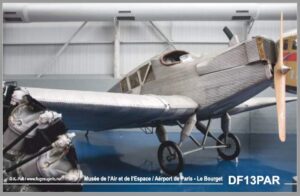6 special call signs symbolise the original, still existing F13 and the replica from the Dessau Museum of Technology.
DF13DEJU
symbolises the Junkers factory in Dessau
 The members of the Ju52 / F13 / J1 working group at the Dessau Museum of Technology have spent years creating this replica of the F13.
The members of the Ju52 / F13 / J1 working group at the Dessau Museum of Technology have spent years creating this replica of the F13.
DF13BUD
symbolises the F 13 in the Közlekedési Múzeum, Budapest.
serial number 574 – Year of manufacture 1920

In the summer of 1921, Junkers Flugzeug- und Motorenwerke delivered a CH-59-registered land aeroplane and a CH-66-registered seaplane to the aviation company Ad Astra Swiss for testing.
The King of Hungary, Charles IV, flew to Hungary in the CH-59 on 20 October 1921 to seize power in a military coup. The aircraft was hired from the Ad Astra company and the pilot Zimmermann was involved in the plan. The attempted coup was crushed. King Charles IV and his companions were exiled to the island of Madeira by the Allies.
The Hungarian government confiscated the aeroplane. Later (1932), the historic aircraft was handed over to the Transport Museum in Budapest.
DF13STO
symbolises the F 13 in the Tekniska museet in Stockholm.
serial number 715 „Schleiereule“ – Year of manufacture 1923

This aircraft was acquired by ABA, AB Aerotransport in 1923. It flew the first half of 1923 with the German registration D 343 ‘Schliervogel’ and was registered as S-AAAC in 1924. The cabin was converted for mail flights in 1926 and became the world’s first flying mailbox, with a letterbox and a ‘postman’. The load capacity was then 2.3 tonnes.
The total flight distance in ABAs service was 334600 km, the total flight time was 2147 hours. The aircraft was handed over to the museum by AB Aerotransport in Stockholm in 1935 and displayed in front of the museum building.
DF13MUC
symbolises the F 13 in the Deutschen Museum München
serial number 2018 or 2019 – Year of manufacture 1926 and 1927

The aircraft exhibited in Munich was sold to the Afghan King Aman Ullah. A revolution broke out in Afghanistan during the first test flights. The royal family fled the country and the aircraft was abandoned at the airfield in Kabul. It was not until 1937 that German supervisors in the Afghan Air Force made the aircraft airworthy again for training purposes.
Kurt H. Weil came to Kabul University as a professor in the 1960s. In 1968, he discovers the damaged fuselage of an F 13 in a scrapyard. In 1969, the Afghan government donates the old Junkers aeroplane to the German Museum.
DF13BLN
symbolises the F 13 in the Deutschen Technikmuseum Berlin.
serial number 2050 „Königsgeier“ – Year of manufacture 1930

The aircraft was used by Air Land Manufacturing in Vancouver and changed hands in May 1933 (company/person is not known). On 23 July 1933, the F 13 crashed after hitting a tree. The four occupants survived the accident with minor injuries. The wreck was salvaged by the Western Canada Aviation Museum in 1981 and was loaned to the German Museum of Technology in Berlin in 2005.
It is currently being restored on behalf of the German Museum of Technology in Hungary and is expected to be back in Berlin in autumn 2019. The museum is currently examining how it can be presented afterwards.
DF13PAR
symbolises the F 13 in the Musée de l’Air et de l’Espace bei Paris.
serial number 609 – Year of manufacture 1920

The first flight took place on 22 November 1920. This aircraft was then based in Holland.
It is one of the seven F 13s that were delivered to France in 1921 as reparations.
